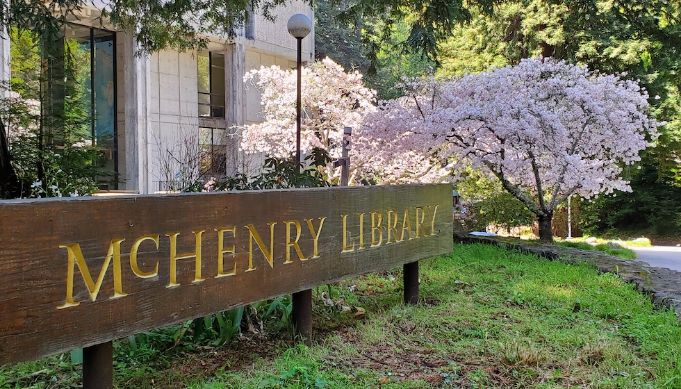
News from University Librarian Elizabeth Cowell
Joop Rubens interviews donor and alumnus Ben Kromnick
Science & Engineering Library opens as a quiet study space for students
UC Library Search: One University, One Library, One Discovery Tool
UC reaches open access agreement with Elsevier
News from University Librarian Elizabeth Cowell
Dear friends of the Library:
Nearly ever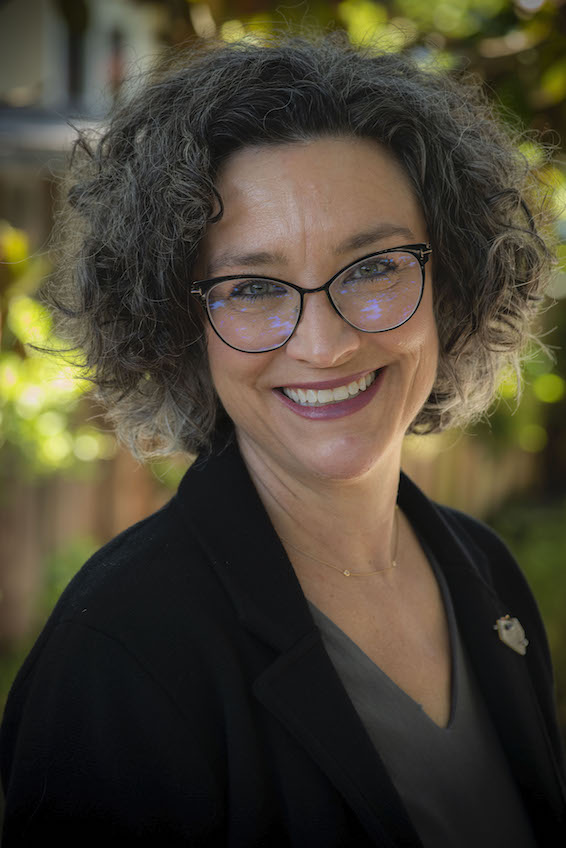 y day this spring, I see signs of our campus coming back to life. The cherry trees are blossoming in front of McHenry Library, just as they do every year, and the bridges over the ravines bring you up close and personal with all the green new growth on the tips of the redwoods. This spring though, I have also been delighted to see the student presence on campus slowly coming back as we all recover from our pandemic year.
y day this spring, I see signs of our campus coming back to life. The cherry trees are blossoming in front of McHenry Library, just as they do every year, and the bridges over the ravines bring you up close and personal with all the green new growth on the tips of the redwoods. This spring though, I have also been delighted to see the student presence on campus slowly coming back as we all recover from our pandemic year.
We are getting ready to welcome students, faculty, and staff back into our two library locations starting July 1. In preparation, we have been running at a limited capacity, with carefully monitored safety protocols in place. During lockdown, we realized that the few students left on campus were stuck in their rooms, feeling isolated and needing a place to study. So we opened the Science & Engineering Library (S&E) to fifty total students at a time, each of whom has to pre-register for a spot and show a negative test to be able to enter.
The check-in process is run by students, with library staff as backup. I really miss working on-site, so I volunteered for a two-hour shift every week, and it’s been wonderful. This unique setup really has been a bridge for both students and staff to get acclimated to being in person again, as we’re all going to have to majorly shift gears before we reopen in two months’ time. It also shows how, throughout the pandemic, we at the Library have remained committed to helping keep our students safe both physically and mentally.
Of course, this was hardly the scenario we originally envisioned for unveiling the newly renovated third floor of the S&E Library. In 2016, we set out to do a study to determine what the pain points were for the students using the S&E Library. We thought we had a good idea of what needed to change, but we needed to do research before committing to a design in order to confirm our ideas.
That study was very generously funded by alumnus Ben Kromnick, and its results were essential to imagining and designing our new layout. Ben was not a STEM major, but as you’ll read here in his interview with Joop Rubens, our Director of Development, Ben loved the S&E Library and maintains a real attachment to the space. That’s why he was delighted to fund our study, which is a great example of how strategically made gifts can have a huge and long-lasting impact on our campus.
On March 8, International Women’s Day, we held a virtual fireside chat with astronaut and oceanographer Kathryn Sullivan, Ecology and Evolutionary Biology Professor Beth Shapiro, and Professor Emerita of Astronomy and Astrophysics Sandra Faber.
The event celebrated the naming of two floors of the S&E Library: the newly renovated Sandra M. Faber Floor (third floor) and the Kathryn D. Sullivan Floor (first floor, due to open in 2022), thanks to two transformational naming gifts from donors Claudia and Alec Webster. Our new chancellor was also there to introduce these trailblazing women in science, and it was a great privilege for me to be able to celebrate International Women’s Day by coming together with this incredible group of women to honor their achievements.
Over 700 people attended their discussion, demonstrating the amazing power of virtual programming to bring together community in a way we never fully anticipated. As the host, it was so fun for me to be able to see who the attendees were, as it revealed a very broad cross-section of gender, race, and age. The reach of these events is certainly one of the best things to come out of the past year, and as restrictions continue to ease, we will no doubt start doing some kind of hybrid programming to combine the best of both virtual and live events.
I hope more positive changes will emerge from this past year of incredible turmoil. I know that we are all very much looking forward to opening on campus this summer, and I hope that the months ahead are a time of safety and respite for you and yours.
My great thanks go to you and your continued support of our campus community.
Sincerely,
Elizabeth Cowell
Richard L. Press University Librarian
Presidential Chair
As many of you know, we are renovating our S&E Library and two of the renovated floors will be named in honor of two amazing scientists. What’s especially cool about this is that these scientists are two women who defied the status quo and succeeded in usually male-dominated fields. It is important to the Library that our students are inspired when they are in our buildings. And we are proud that celebrating Sandy Faber and Kathy Sullivan will help our students, no matter their gender, dream about unlocking their own potential.
We had an ev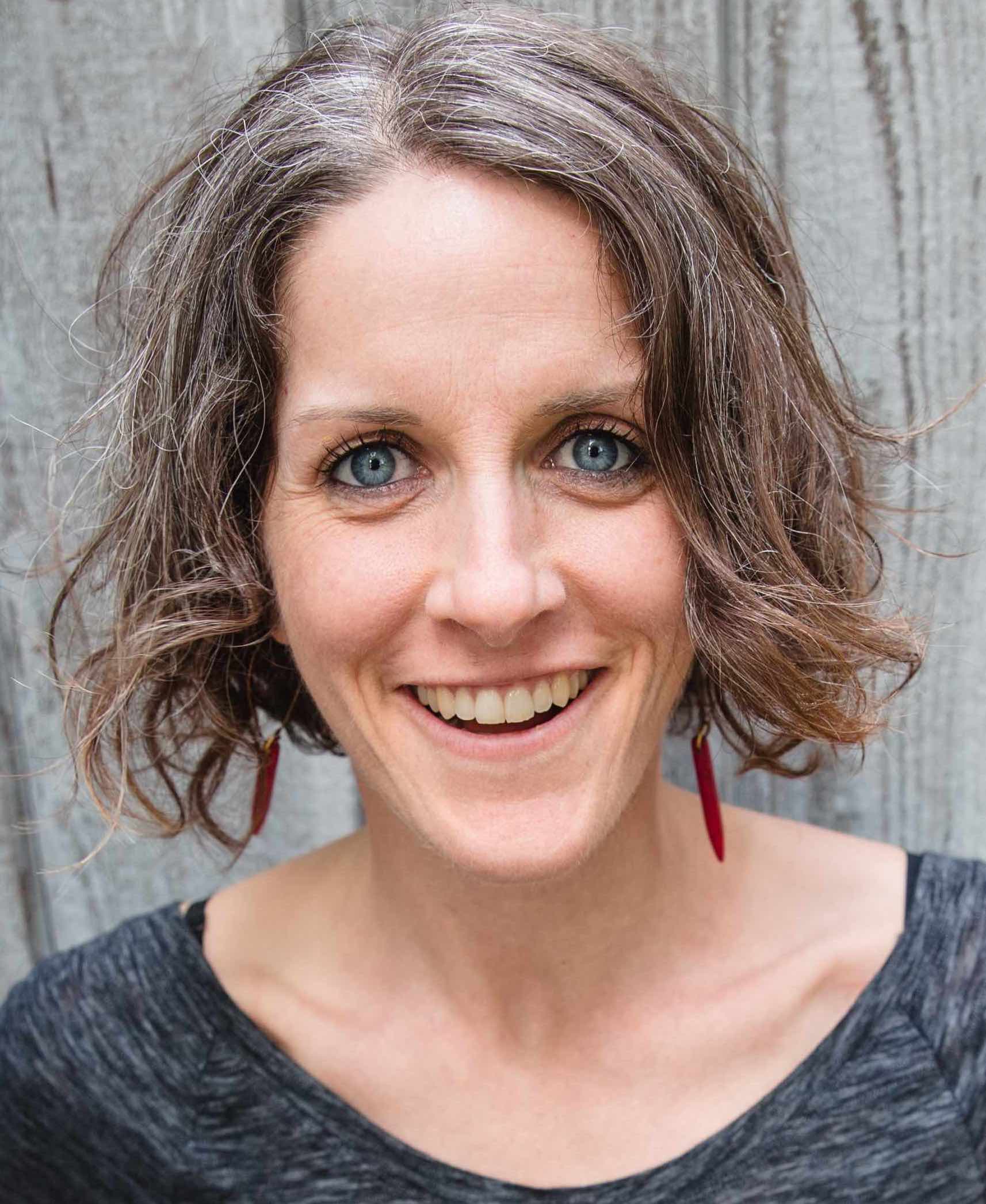 ent on March 8 to celebrate Sandy and Kathy and the naming of our two floors in their honor. Now, due to family concerns, I was unable to attend the fireside chat between astronaut and oceanographer Kathryn D. Sullivan and UC Santa Cruz Professor Emerita of Astronomy and Astrophysics Sandra Faber. When I watched the recording of the event afterward, I no longer felt bad for prioritizing family time. Dr. Faber described how she started her career as an assistant professor and the first female staff member of the Lick Observatory while she was also pregnant. There were no UC maternity leave policies at that time, but thanks to Lick Observatory Director Robert P. Kraft, she received flexibility and understanding throughout her pregnancy and the beginning of her career.
ent on March 8 to celebrate Sandy and Kathy and the naming of our two floors in their honor. Now, due to family concerns, I was unable to attend the fireside chat between astronaut and oceanographer Kathryn D. Sullivan and UC Santa Cruz Professor Emerita of Astronomy and Astrophysics Sandra Faber. When I watched the recording of the event afterward, I no longer felt bad for prioritizing family time. Dr. Faber described how she started her career as an assistant professor and the first female staff member of the Lick Observatory while she was also pregnant. There were no UC maternity leave policies at that time, but thanks to Lick Observatory Director Robert P. Kraft, she received flexibility and understanding throughout her pregnancy and the beginning of her career.
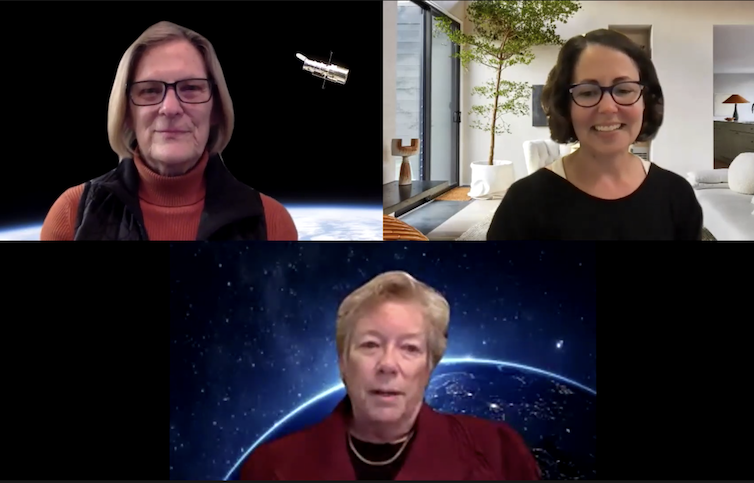 Balancing career with family is just one of the many obstacles women face on their way to the top of their chosen field. These concerns and so many others often hold women back from reaching their full capability, but not these two. Fittingly, their chat (moderated by Professor Beth Shapiro, herself a trailblazing woman of science) took place on International Women’s Day. I can’t think of a better way to celebrate women’s achievements than by naming two floors of our Science and Engineering Library after these two incredible people.
Balancing career with family is just one of the many obstacles women face on their way to the top of their chosen field. These concerns and so many others often hold women back from reaching their full capability, but not these two. Fittingly, their chat (moderated by Professor Beth Shapiro, herself a trailblazing woman of science) took place on International Women’s Day. I can’t think of a better way to celebrate women’s achievements than by naming two floors of our Science and Engineering Library after these two incredible people.
The conversation began with a discussion of the hurdles each of these women faced at the outset of their work. Both Sullivan and Faber graciously gave credit to the groundwork others had laid out before them, saying that the “door was already ajar” for them to go through. Sullivan said that she’s had a “blessed life” with regards to other women coming first — but even so, their early careers were not without hiccups and mishaps due to their gender.
Sullivan said most of the prejudice she encountered at the outset was of the more benign type. Her male colleagues enjoyed being in the field because there they could “be little boys again… tell raunchy jokes, burp, or hang around in their underwear… and now there’s going to be a woman here to make them feel more self-conscious about that.”
As a young astronomer, however, Dr. Faber experienced much more blatant sexism when she visited the Palomar Observatory in San Diego County. The housing quarters there were called the “Monastery,” implying by their very name that they were single-gender housing. Faber was able to stay at the gatekeeper’s house instead, but she then found even stricter segregation when she arrived at the housing facilities of the Mt. Wilson Observatory in Los Angeles: a red rope sectioned off one portion of the entryway, with a sign that said Female upstairs. They had dedicated the entire upstairs floor of their housing to her in order to keep her safe and secure during her time there!
From there, the conversation turned to UC Santa Cruz, where Sullivan went as an undergrad. She started out as a Russian linguist, as she was a self-described “map fanatic” and wanted to do anything that would pay her to travel. To her consternation,her advisor insisted that she include one natur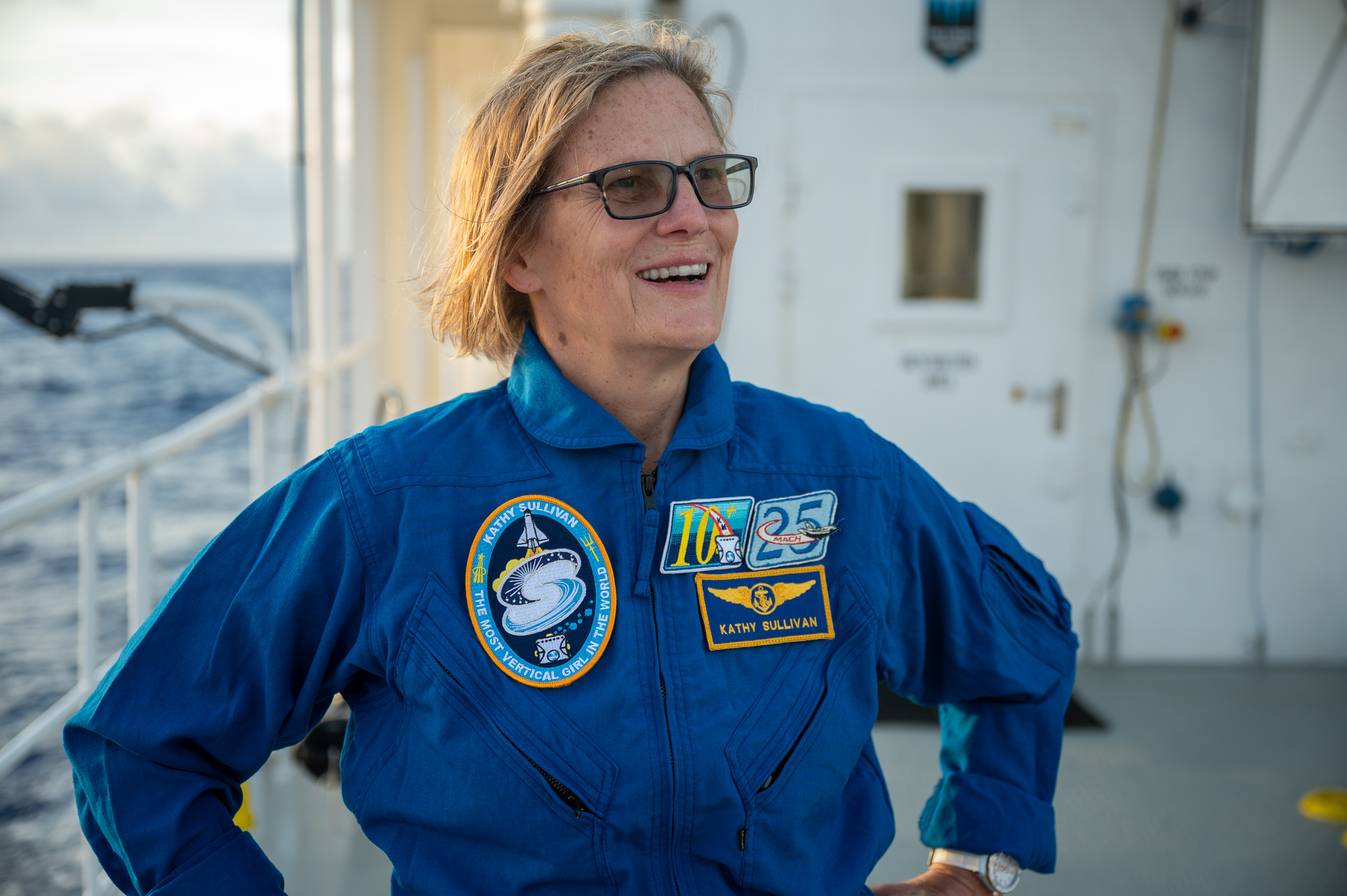 al science class every quarter of her first year in order to meet the campus’s breadth requirements. She reluctantly did so, and, well, clearly the rest was history.
al science class every quarter of her first year in order to meet the campus’s breadth requirements. She reluctantly did so, and, well, clearly the rest was history.
Sullivan’s undergraduate career was helped along by Professor of Oceanography Gary Griggs, whose class Sullivan described as “pretty irresistible.” As a demonstration of UCSC’s commitment to its undergrads, Sullivan said, Griggs nurtured her curiosity about oceanography by showing her around his lab and mentoring her on what to take next if she did want to pursue a career in natural sciences. His suggestion? Optical mineralogy, which she is very proud of having passed despite never having taken a formal trigonometry class at school. Talk about a trial by fire.
These two pioneers also talked about the Hubble Space Telescope, which brought their teams together professionally for the first time in 1990. The telescope’s deployment was delayed in part by the tragedy of the Challenger crash in 1986, which put everything on hold indefinitely as NASA and the world reeled from the repercussions. Sullivan herself was classmates with four of the people killed in the disaster, but still, she said, despite the personal tragedy, “it did not change my sense of the risk of going to space… [that’s] an irreducible risk that’s never going to be zero.”
Faber in turn discussed the “dark moment” in which her team first recognized and then diagnosed a nearly fatal flaw in the Hubble telescope based on errors in images taken by their camera. Faber describes that time as the “most intense investigative period of my life,” one both infused with triumph at having been the ones to discover the issue but then also a real “sense of tragedy.” Following both of these massive setbacks to the space program, both women remembered an atmosphere of real concern that NASA would die out or be canceled. But in this case, Faber says, they “picked up the very next day,” and “courage and imagination really won the day in the end.”
Regarding the future of space exploration, both women agreed that they want to use the perspective afforded by astronomy to better understand and improve conditions here on earth. Faber discussed the Earth Futures Institute at UCSC, which she says is not just about “science or economics or health, it’s about values.” What is the value of Earth, she asked, or of intelligent life? This is a crucial moment in the history of the human species, as we are not only able but obligated to think about these issues for the very first time — and the ramifications of doing so (or not) will be felt for “decades and eons to come.”
Sullivan agreed, saying that as an astronaut, you can “dine out on your vacation pictures forever.” But she has always wanted to use her experience to guide us in living more wisely, she said, more informed by the bigger view. (For the record, Sullivan would also love just one more space flight — “and if the moon happened to be involved," she said, "I wouldn’t object.”)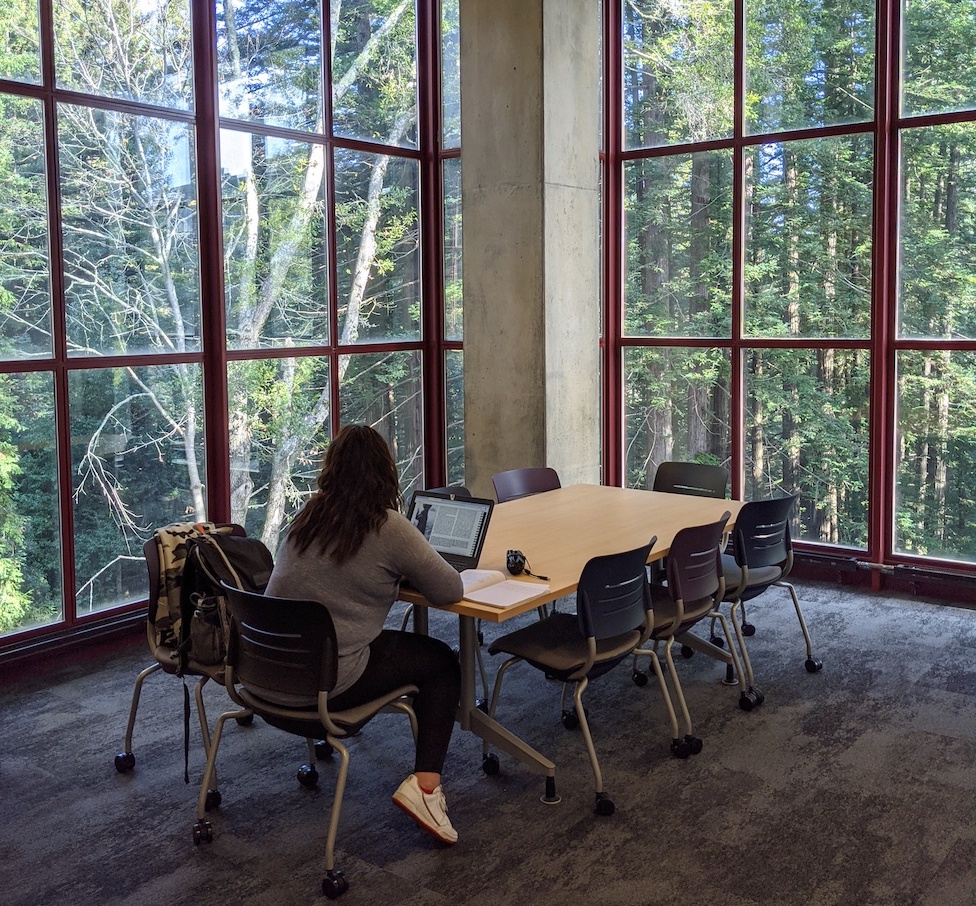
Thankfully, formulating that bigger view is entirely possible right here at UCSC. When asked what advice these women would give to students now, both replied, “Go to the library!” And not just accessing its digital materials, either, but by actually physically going there to study. By doing so, they said, you build community, you socialize, and you learn from the people around you.
Faber wrapped up their talk by saying, “I could not applaud more our new vision for the Science Library at UCSC, and the wonderful things the Websters are making possible there… I am so pleased that my name is going to be associated with a piece of this library, because I think it’s the most beautiful building on campus.” Sitting on the third floor of the Science & Engineering Library, surrounded by astronomical pictures and looking out at the beauty of the redwoods--that’s “food for the soul.”
I happen to agree. As a businesswoman and entrepreneur, I felt very much inspired by these women discussing their roles in some of the most important developments in our scientific history. As Shapiro pointed out, our students can now quite literally look up to these women, whose names will soon be spelled out in big letters on their respective floors of our lovely library. Who knows what new discoveries or innovations that sight will inspire?
Joop Rubens interviews donor and alumnus Ben Kromnick
Prior to starting the Science & Engineering Library renovation, we needed more data to help us understand the biggest challenges our students are facing. Given our increasingly diverse student population, how can a library reimagine itself while remaining a powerful equalizer on campus? How do we ensure that a renewed S&E Library specifically addresses today’s student needs?
The only downside: conducting research can be expensive. Thankfully, in 2016, UCSC alumnus Ben Kromnick decided to fund a large part of our renovation research. His support not only allowed us to gather the data we needed to help us envision the new floorplan, but it also strengthened our case with other donors, allowing us to finalize the large gifts we needed to fund the renovation.
Now that we are getting close to finishing the S&E transformation, I wanted to catch up with Ben and celebrate what his original support allowed us to accomplish. My conversation with him is below.
What was it like being a student at UC Santa Cruz?
My time at UC Santa Cruz was incredible. I remember when I first visited the campus: I was with my mom, standing in front of what was going to be my room at College 8, and sure enough, three deer were grazing right in front of my dorm. Immediately I knew this was a different kind of place. It is a place where you are constantly surrounded by magic.
As a student, UC Santa Cruz was a wonderful mix of new challenges. There was certainly the experience of finding myself — think we all go thr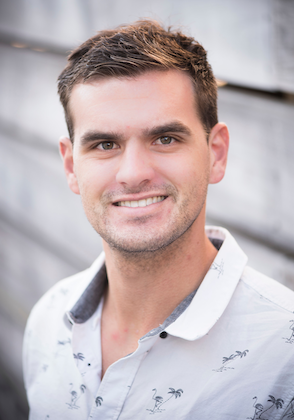 ough that in college. But a major shift happened for me during the first quarter of my freshman year. Up ‘til then, I thought history was going to be my minor. It was a passion topic, and I loved it, but I also assumed that history was merely an entry point, not the main reason I went to college.
ough that in college. But a major shift happened for me during the first quarter of my freshman year. Up ‘til then, I thought history was going to be my minor. It was a passion topic, and I loved it, but I also assumed that history was merely an entry point, not the main reason I went to college.
That first quarter though, I fell in love with every single class and every single professor I had. Those history lectures at UC Santa Cruz helped me realize that whatever your passions are, you can find a way to build a life around that. What a fulfilling thing to learn! The “following your passion” attitude is something I first adopted at Santa Cruz. I was constantly surrounded by people completely engaged in what they pursued, researched, and taught. For me, that was history and politics.
Of course, I also learned what I did not like: college mathematics. I originally thought I would be an economics major, but guess what? My first math class slapped me in the face. I realized pretty quickly that I was just not passionate enough about economics if math was going to be such a big part of it.
In general, I found UC Santa Cruz to be a place with endless opportunities. I was able to work while being a student, and I was able to study abroad while still doing an average of twenty credits per quarter. Not to mention the jaw-dropping moments that happen at Santa Cruz — you get to live and learn in a stunning setting. You’re walking to class, turn the corner, and boom — there's the entire Monterey Bay, just sitting there being beautiful on a sunny day. The sun is blinding off the ocean. Incredible. Seeing that every day teaches you that life can be both beautiful and invigorating. You learn to appreciate and see the beauty in life at UC Santa Cruz.
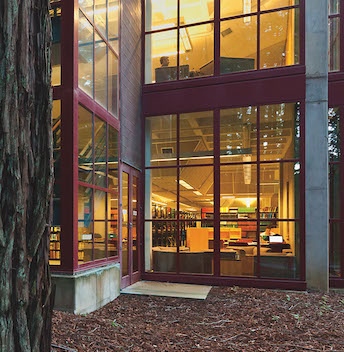 One of my favorite places on campus was the library. I remember studying with friends on the bottom floor of the Science & Engineering Library. We studied our tails off, but it became a social hub for us as well. All day long, people would cycle through. We would get there at eight in the morning, get a table, put down our backpacks, and create a study station. We’d pop out for lunch really quick, only to return and study with the afternoon crowd. Again, pop out for dinner, and back with the evening crowd before heading home.
One of my favorite places on campus was the library. I remember studying with friends on the bottom floor of the Science & Engineering Library. We studied our tails off, but it became a social hub for us as well. All day long, people would cycle through. We would get there at eight in the morning, get a table, put down our backpacks, and create a study station. We’d pop out for lunch really quick, only to return and study with the afternoon crowd. Again, pop out for dinner, and back with the evening crowd before heading home.
The academic community that forms around you at the library is such an important part of the student experience. I met many friends there; people I still am in touch with to this day.
How did UC Santa Cruz impact your early career?
Like many others, I took my History and Global Comparative Politics degrees and went into tech. But see, I was lucky to have this mixed academic experience from UC Santa Cruz, where we focused on European history and on Global Comparative Politics. My degree taught me how to think critically, and it prepared me well for a day job that needed me to focus on technology and market strategies.
I also interned at Plantronics during my time at UCSC, and after graduating, I ended up getting a job there to work on their corporate strategy and overall technology strategy. I helped develop and launch products globally, which is just incredible when you're in your early twenties.
After that, I went into technology consulting with Deloitte, which led me to catch the startup bug. Ever since, I've been starting companies and helping companies come up to scale, mostly in the healthcare technology space but also in the finance space. What’s funny is, now I interview people a lot for roles in different companies, and they often have an economics degree or an MBA. In some cases, they have a grad degree in epidemiology, chemistry, or biology. But what I mostly find is that people who are the most successful in non-technical roles usually have a more varied educational background — people who came out of the movie industry or who studied literature, or philosophy.
This is what I call the “humanist perspective.” It is important that people learn how to find solutions by looking at all sorts of angles. The discipline of thought and the philosophy of thought — this is something I use every single day in my techie Silicon Valley job. I use my European history and comparative politics skills every single day.
Why was the library important to you when you were a student?
As a freshman, the library at first seemed intimidating. I came from a high school where we didn't have a library. Well, in fact, we did have one. But no one went there to study. We would study at home. Once I was at college though, I needed a way to separate my spaces, and I needed a place to focus. So for me and most of my friends, going to the library meant we were there to work and study. It allowed us to segment our lives.
The library also helped us hold each other accountable. Not in a downtrodden way, such as “Oh my God. We have to go study now.” No, more in a motivating way, such as “Hey! I've got a test coming up, and you have some tests coming up. Let's go! Let's help each other. We can do this.” We would stay focused together, and then we knew we deserved to have all the fun in the world afterwards.
The library was a place for discipline. A place that offered the academic community you need around you when there is so much to learn. This was another important growth element of my college life: thanks to the UC Santa Cruz Library, I learned how to stay focused and be productive when it matters.
So the library was the intermedi ary stop between courses, a place that allowed you to stay productive and stay focused. But at the same time, it also served as a social hub. If students had a morning class and later an early afternoon class, they were all in the library for lunch, studying or preparing for the next class. So we would create friendships there. If you're always in the library at the same time every day, with the same people, they become your friends. I have dozens of friends who I met at the S&E Library, long-term friendships to this day, all because we happened to sit at the same table one day.
ary stop between courses, a place that allowed you to stay productive and stay focused. But at the same time, it also served as a social hub. If students had a morning class and later an early afternoon class, they were all in the library for lunch, studying or preparing for the next class. So we would create friendships there. If you're always in the library at the same time every day, with the same people, they become your friends. I have dozens of friends who I met at the S&E Library, long-term friendships to this day, all because we happened to sit at the same table one day.
You have mentioned to me before that you had an aunt who helped you with your tuition while you were UC Santa Cruz. Can you tell me a little bit about her and why she helped you?
My Great Aunt Audrey had a huge impact on my life. She was my father's mother's sister. You know, my grandmother was a teacher her whole life; my mother is a teacher and has been her whole life. On the contrary, my Great Aunt Audrey never had a career, and she never had children of her own. She came to see my father as a son in a lot of ways.
To Audrey, education was always a top priority. It’s somewhat of a Jewish tradition, especially to the older Jewish community. Education is an obligation. It starts with learning how to read the Torah, which is an obligation of every man in the community, but that culture extends out of the religious sphere and into general life. Learning is an assumed priority.
Although my Great Aunt Audrey didn't have a large extended family, she had a very large Jewish community around her in Atlantic City — it is one of the oldest in the country, in fact. And so for her, my education, my sister’s education, and my father's education were always a huge priority. She was lucky enough to have the means, so she invested in our education.
Her support made me feel responsible to perform. I wasn't going to be a C student, Audrey would not have liked that. I wanted her to feel that her kindness and her generosity was being fulfilled and carried forward, so I studied hard and succeeded. I owe a lot to her.
Why did you decide to fund our research study? It's an unusual project to support.
I actually credit the internships I did in college for helping me shape my philosophy of giving. Look, it is really hard to make big strategic decisions without good information. It's really hard to know what you don't know, and it's really hard to prove what you know without the underlying data.
As I have grown throughout my career, I have learned that the foundational understandings of the world around us is what ultimately shapes the best ideas. We can have hypotheses and visions of where we want things to go. But if the data doesn't support it, it's a really hard path to trudge through. Data is powerful.
Now, when I give to institutions, I usually look at two things — similar to how I invest in companies. You invest in jockeys, not horses. You invest in a team first, the best people. And then you figure out: what is the one critical thing that they need? What will unlock their potential?
To get there, I often ask entrepreneurs, nonprofit leaders, and higher education leaders the same question: “If you had all the money in the world, what would you spend it on right now?” Often the answer is, “If I had more data on my customers’ (or constituents’) exact needs, I would spend all that money on responding to those needs.” But investing in assembling good data is not popular, because it’s hard to see a tangible return. Yet if you look at the most successful companies in the world — Google, Facebook, Oracle, Amazon — they have built economic engines that allow them to spend a lot of money on research and on testing and iteration. The nonprofit sector and the higher education sector rarely get that opportunity.
So, when I find a leadership team that wants to invest in gathering data before forming their full plan, that to me is often a very good indicator that this is a team worth investing in. That's the background of why I wanted to fund the S&E renovation research.
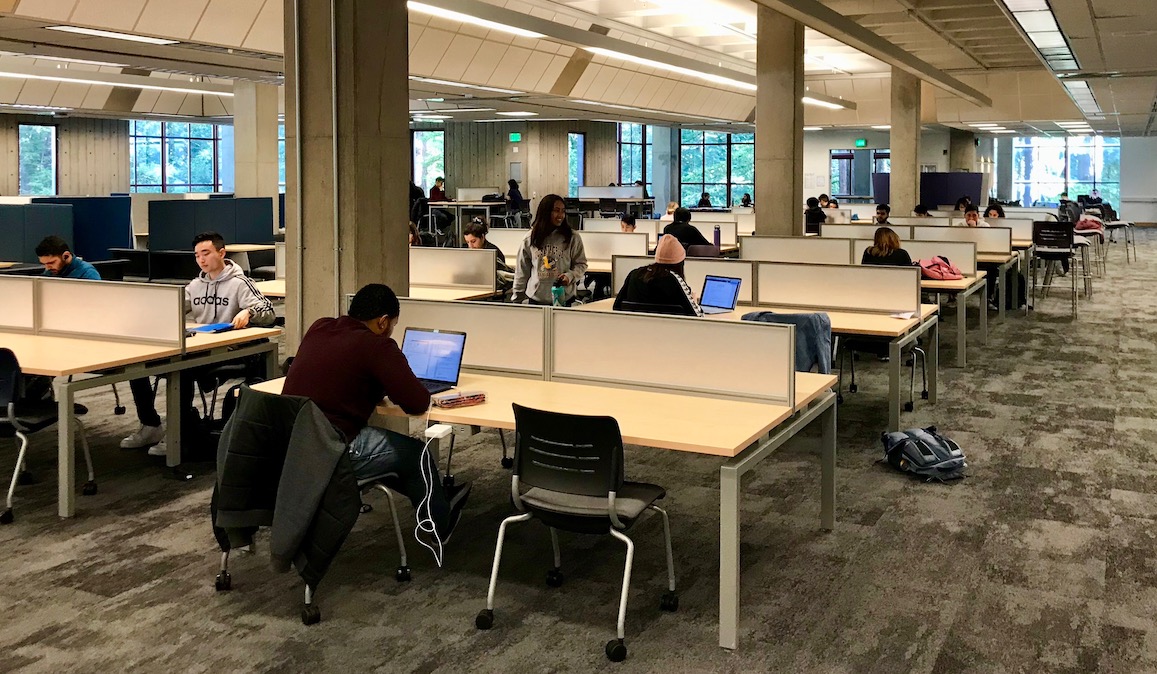 How does it feel to have been an early supporter now that we're close to a fully transformed S&E Library?
How does it feel to have been an early supporter now that we're close to a fully transformed S&E Library?
I'm so excited. I really just want to see the space in action. I'm so proud of the work that the library team has done to get it this far, and I am proud of the help I was able to provide to get it started.
It is exciting to see UC Santa Cruz as an institution take these next steps. The S&E transformation is a symbol of the school’s progress, just like when McHenry library was renovated — that was also a great example of institution-wide advancement. Everybody benefitted from that success, and same with the S&E library now.
This is a lot of hard work coming to fruition, and it’s a strategic project that will enhance the identity of UC Santa Cruz. All students and faculty will benefit, no matter what their major. Our Science & Engineering Library is next to the biomedical sciences building, right on top of some of the most innovative research labs in the world. Previously, it didn't quite measure up, but now it will. That is so exciting to me. I cannot wait to come back and maybe even do some remote work there.
If you could share something with our current students, what would you tell them?
Something my father shared with me when I was heading to college. He told me that there are very few moments in your life where you can commit yourself to just learning. That’s why you’re in college. You even get to pick what you learn about! That is an incredible blessing and a rare opportunity.
At times, I've been able to structure my career in a way that has allowed me to continue to learn, but that is not always easy. However, while you are a student at UC Santa Cruz, the choices are wide open to you. So, it is up to you: how much time and effort are you going to put into that learning?
Know that whatever you put into it, you'll get so much more out of it. So take advantage of the opportunity. It's a special time, and it does not last forever.
At the end of the 2019/2020 academic year we realized that the CART Fellowship Program would need to be reconceived for the 2020/2021 academic year, and CART Archivist Alix Norton, did so with great success. Our four CART fellows each developed a unique research project focused on our collections. The resulting projects are testaments to their resilience, resourcefulness and creativity. The individual projects and their creators are listed below. We encourage you all to explore and learn a bit more about some of our unique holdings.
2020/2021 CART Fellows:
• Joseph Finkel (Musicology): "If I had to live my life over again, I would be a botanist"
• Anny L. Mogollón (Literature): seeds and whispers
• Eric Sneathen (Literature): Another Renga
• Brock Stuessi (Ethnomusicology): Echoes of Seema
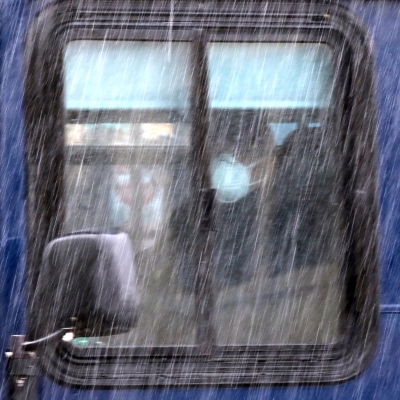
We are also pleased to share with you the newest Regional History Project publication, The Empty Year, a profound and moving testament to the past year in the form of oral history. Irene Reti conceived of the project and was awarded a Radical Resilience mini grant to train a small cohort of students in oral history. Alumnus and regular contributor to the Regional History Program, Cameron Vanderscoff, led the effort in training and mentoring the students as they worked to document how members of their communities were impacted by Covid-19.
We were also thrilled to collabora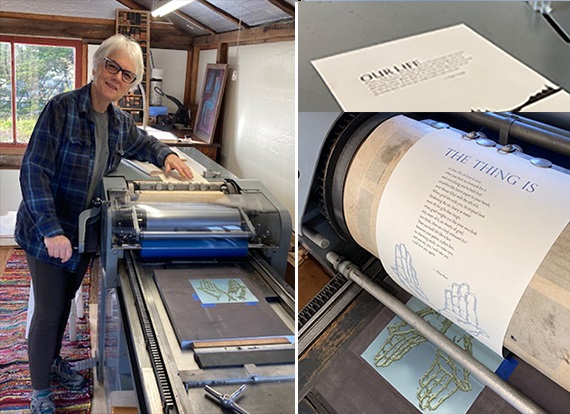 te with the Institute of Arts and Sciences this past January in an event celebrating the work of book artist Felicia Rice and Moving Parts Press (the event was recorded and can be viewed here). In June 2020, Felicia Rice completed her most recent work, The Necropolitics of Extraction. An edition of 50, the book is made up of one long print (over 17 feet long) commenting on the rapacious aspects of extraction which resolves in a call to action by T. J. Demos. Two months later that book, along with Rice's studio, was destroyed by the wildfires that ravaged the Santa Cruz Mountains. Despite this massive loss Rice remains committed to creating works exploring and commenting on some of the most tangled issues of our time, from questions surrounding identity to the sustainability of our planet. The event invited a number of Rice’s collaborators to join in conversation about her work, the process of collaboration, and the power of artists’ books to fuel our collective imaginations as we work to cultivate futures of social justice.
te with the Institute of Arts and Sciences this past January in an event celebrating the work of book artist Felicia Rice and Moving Parts Press (the event was recorded and can be viewed here). In June 2020, Felicia Rice completed her most recent work, The Necropolitics of Extraction. An edition of 50, the book is made up of one long print (over 17 feet long) commenting on the rapacious aspects of extraction which resolves in a call to action by T. J. Demos. Two months later that book, along with Rice's studio, was destroyed by the wildfires that ravaged the Santa Cruz Mountains. Despite this massive loss Rice remains committed to creating works exploring and commenting on some of the most tangled issues of our time, from questions surrounding identity to the sustainability of our planet. The event invited a number of Rice’s collaborators to join in conversation about her work, the process of collaboration, and the power of artists’ books to fuel our collective imaginations as we work to cultivate futures of social justice.
Science & Engineering Library opens as a quiet study space for students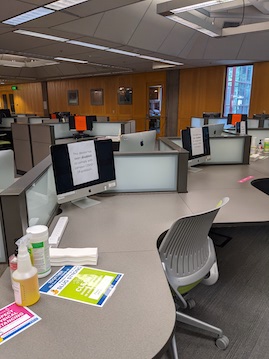
In winter quarter, the University Library began to offer reservable individual quiet study spaces with access to power/wifi in the Science & Engineering Library to currently registered students who live on or off campus. Students have responded that the study space has helped manage the isolating feeling of being on campus without the interaction of in-person classes.
Students can reserve individual spaces for up to four hours by using the library resource reservation system.
Students must be registered with the Student Health Center for COVID-19 symptom screenings/testing and present a GREEN Health e-Messenger Badge before entering. Once inside, students are required to wear masks at all times, observe physical distancing, and wipe down study space surfaces with provided disinfectant supplies before/after use. The S&E Library study spaces do not include access to library collections or other physical resources, public computing/printing, classrooms, offices, or group study rooms.
UC Library Search: One University, One Library, One Discovery Tool
On July 27th, a sweeping new project will unify the UC Santa Cruz University Library's vast collections with the collections of the other nine University of California libraries under one virtual roof.
UC Library Search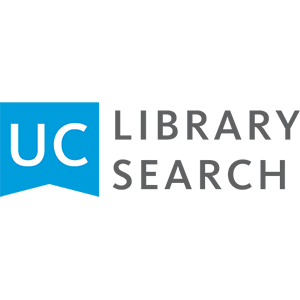 will bring all UC campus libraries together into the same system, just as a public library system uses one catalog for its many branches. UC Library Search will allow patrons to find resources from any campus quickly and simply, saving time and effort.
will bring all UC campus libraries together into the same system, just as a public library system uses one catalog for its many branches. UC Library Search will allow patrons to find resources from any campus quickly and simply, saving time and effort.
UC Library Search expands the capabilities of our local catalog. The main difference is that patrons will no longer have to go through a separate system (Melvyl) to find and request items from outside their home campus. Patrons will easily be able to see what they have borrowed, request extensions, and manage their account without needing to log in to the local catalog, Melvyl, and Interlibrary Loan (ILL) separately.
For more information, including an updated FAQ, please see our UC Library Search website.
UC reaches open access agreement with Elsevier
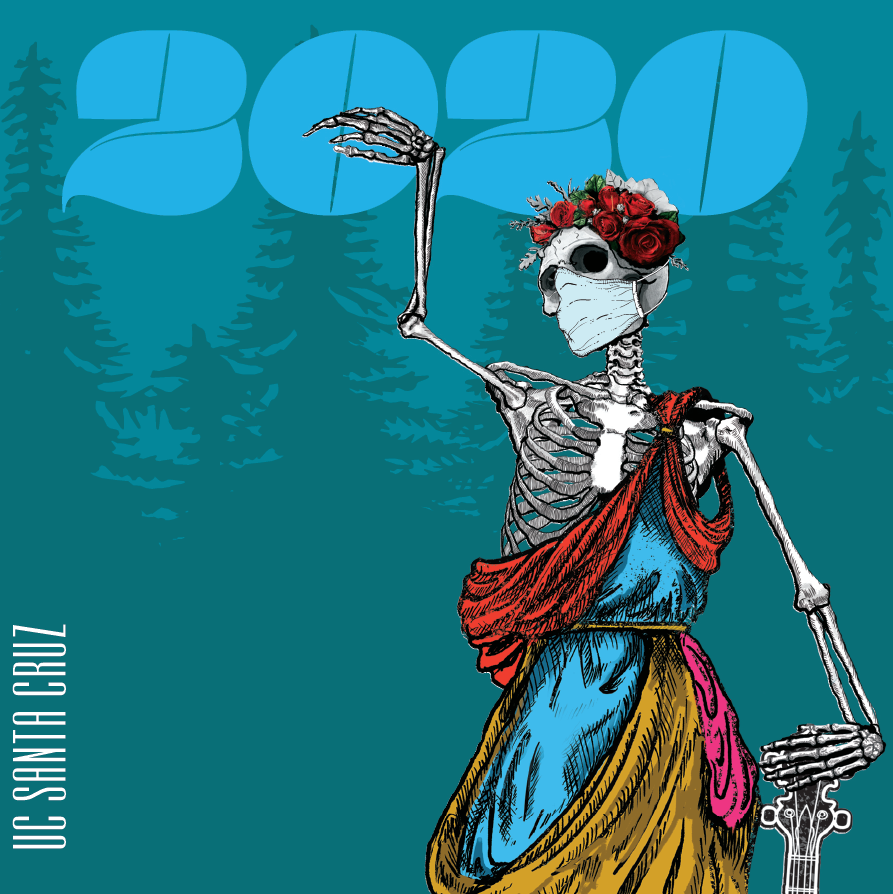
Credits:
Contributors: Elizabeth Cowell, Zoe Quinton, Joop Rubens, Linda Hunt, and Teresa Mora
Production: Linda Hunt
Copyediting: Greg Careaga
Photography: Linda Hunt, Joop Rubens, Greg Careaga, Enrique Alvarez, and John Bono

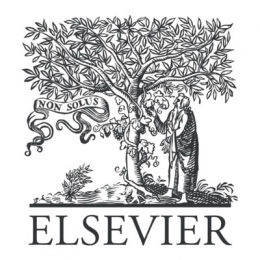
 Santa Cruz, CA
Santa Cruz, CA



